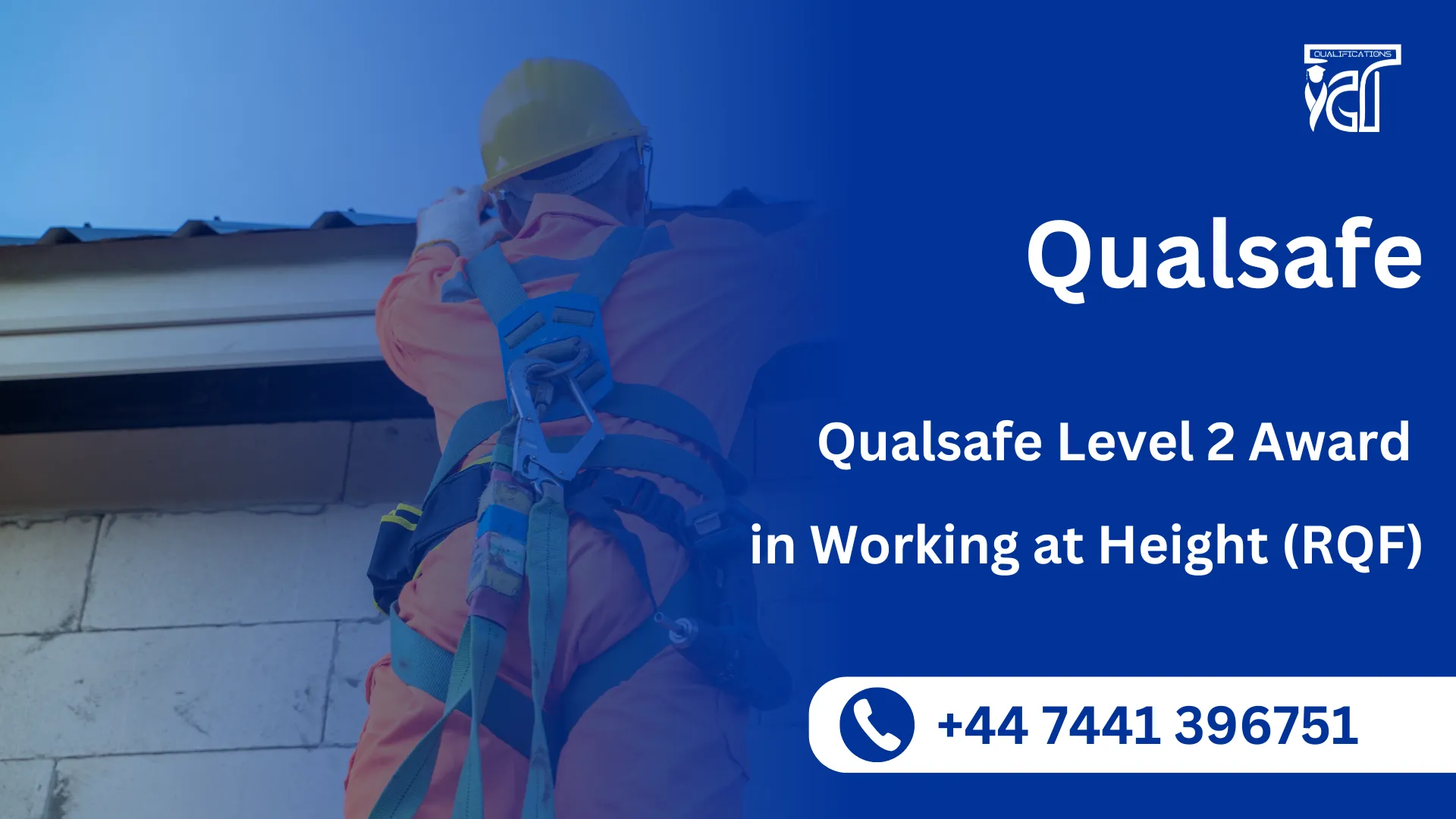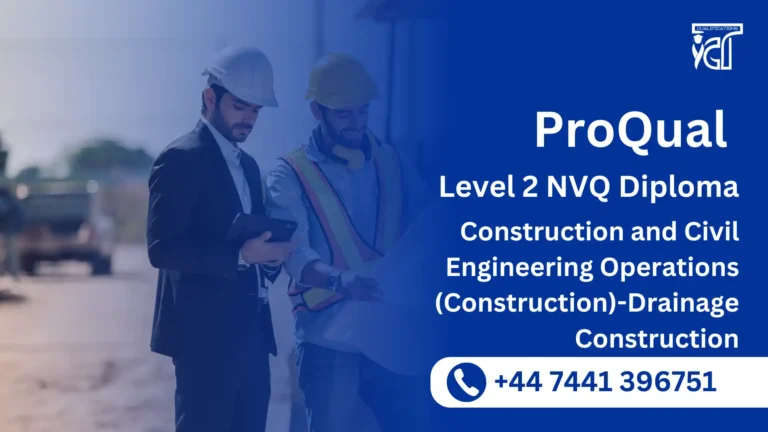In any industry that involves working at height, safety is paramount. The Qualsafe Level 2 Award in Working at Height (RQF) provides the essential knowledge and skills to ensure that individuals can work safely and competently at height, reducing the risk of accidents and injuries. This Ofqual-regulated qualification is entirely assignment-based, offering flexibility for learners to study at their own pace while gaining practical and actionable skills.
The Qualsafe Level 2 Award in Working at Height (RQF) is specifically designed for individuals who are required to perform tasks at height, such as construction workers, maintenance personnel, and anyone involved in jobs that expose them to potential fall hazards. The course provides a comprehensive understanding of working at height safely, covering the key aspects of hazard identification, risk assessment, and the use of equipment to ensure safety.
As an Ofqual-regulated qualification, this course meets the strict standards of the UK educational framework, ensuring that it is recognized and valued across various industries. With an entirely assignment-based structure, learners have the flexibility to complete their assessments independently, making it an ideal option for busy professionals or organizations that need to train their staff efficiently.
The Qualsafe Level 2 Award in Working at Height (RQF) offers a detailed and thorough understanding of safe practices when working at height. It covers essential topics such as risk assessments, safety equipment, fall protection systems, and emergency procedures.
This qualification is ideal for employees or contractors who need to demonstrate competence in working at height in line with industry regulations. The RQF framework ensures that the course adheres to high educational standards, providing learners with the skills they need to work safely and effectively.
The Qualsafe Level 2 Award in Working at Height (RQF) is a crucial qualification for anyone working in industries where tasks at height are necessary. This Ofqual-regulated and assignment-based course equips you with the skills and knowledge to perform these tasks safely, ensuring that you meet legal requirements and industry best practices.
By gaining this qualification, you are not only enhancing your own skills but also contributing to a safer workplace environment, reducing the risk of accidents and promoting safety culture within your team. Whether you are already working at height or preparing for future roles, the Qualsafe Level 2 Award in Working at Height (RQF) is an essential qualification that can open doors to better career opportunities and improved workplace safety standards.
Qualsafe Level 2 Award in Working at Height (RQF)
This qualification contains 1 mandatory unit with a Total Qualification Time (TQT) of 3 hours.
| Sr# | Unit Title |
|---|---|
| 1 | Principles of working at height |
GLH (Guided Learning Hours) and TQT (Total Qualification Time) are terms commonly used in vocational qualifications to help define the amount of time a learner is expected to spend on their studies.
1. GLH (Guided Learning Hours)
GLH refers to the number of hours a learner spends being directly taught, supervised, or supported during their course. This includes the time spent in activities such as:
- Classroom instruction
- Practical workshops
- One-on-one tutoring or mentoring sessions
- Online learning sessions with tutor support
In other words, GLH represents the time that learners are actively engaged with their instructors or learning activities.
2. TQT (Total Qualification Time)
TQT represents the total amount of time a learner is expected to invest in completing a qualification, including:
- GLH (Guided Learning Hours): Time spent on direct learning, as explained above.
- Self-Directed Learning: This includes time spent on independent study, research, assignment completion, preparation for exams, and any other work the learner does outside of direct teaching hours.
TQT is a broader measure that includes all the time required to achieve the qualification. It helps learners and employers understand the overall commitment required for the qualification.
Key Differences Between GLH and TQT:
- GLH focuses on direct learning with guidance or supervision.
- TQT includes GLH as well as independent study time and other learning-related activities.
Example:
If a qualification has a TQT of 600 hours and a GLH of 250 hours, it means the learner should spend 250 hours in direct learning (classroom, online, or tutor-led sessions) and 350 hours on independent study or research.
Learning Outcomes for Principles of Working at Height:
Upon completion of the Principles of Working at Height unit in the Qualsafe Level 2 Award in Working at Height (RQF), learners will be able to:
- Identify Key Legislation and Regulations:
- Understand and explain the relevant safety legislation, regulations, and standards that govern working at height, such as the Work at Height Regulations (2005) and the Health and Safety at Work Act.
- Recognize the Hazards Associated with Working at Height:
- Identify common hazards related to working at height, including falls, falling objects, unstable surfaces, and environmental factors such as weather conditions.
- Understand the Importance of Risk Assessment:
- Demonstrate the ability to conduct a risk assessment prior to working at height, assessing potential risks and determining necessary safety measures and controls.
- Apply Safe Working Practices:
- Describe and apply safe working practices when working at height, including the use of appropriate personal protective equipment (PPE), fall protection systems, and safe access methods.
- Explain the Role of Equipment in Ensuring Safety:
- Understand the importance of using suitable and well-maintained equipment such as ladders, scaffolding, and harnesses to minimize risks while working at height.
- Promote a Culture of Safety:
- Understand the principles of fostering a safety-conscious environment when working at height, ensuring that all team members adhere to safety protocols and procedures.
- Recognize the Importance of Supervision and Training:
- Explain the necessity of supervision, ongoing training, and competency checks to ensure that individuals working at height have the appropriate skills and knowledge to do so safely.
Benefits of the Qualsafe Level 2 Award in Working at Height (RQF)
The Qualsafe Level 2 Award in Working at Height (RQF) offers numerous benefits for individuals and organizations, making it an essential qualification for anyone involved in tasks that require working at height. This Ofqual-regulated qualification is designed to provide learners with the knowledge and skills needed to work safely and efficiently, reducing risks and enhancing workplace safety. Below are the key benefits of this highly regarded qualification:
1. Ofqual-Regulated and Industry-Recognized Qualification
The Qualsafe Level 2 Award in Working at Height (RQF) is an Ofqual-regulated qualification, ensuring it meets the rigorous standards set by the UK’s national regulatory body. It is widely recognized across the industry, making it a valuable certification for professionals in construction, maintenance, facilities management, and other sectors where working at height is common. This globally accepted qualification boosts your credibility and employability in the workplace.
2. Flexible, Assignment-Based Learning
One of the standout features of this qualification is its assignment-based format. Learners can complete the course at their own pace, allowing for flexibility to study around their work or personal commitments. This flexibility makes it easier for busy professionals to gain the necessary qualifications without disrupting their daily routines. Whether you’re an individual looking to enhance your skills or an employer seeking to train your team, this format is convenient and accessible.
3. Enhance Workplace Safety and Compliance
The Qualsafe Level 2 Award in Working at Height (RQF) helps you adhere to health and safety regulations, reducing the likelihood of accidents and injuries on the job. By learning how to properly assess risks, select the right equipment, and implement safe working practices, you can ensure compliance with industry regulations and create a safer work environment. This course provides vital knowledge that can help businesses avoid costly fines and legal repercussions associated with non-compliance.
4. Develop Practical, Real-World Skills
This qualification focuses on practical, hands-on learning that can be directly applied to real-world work scenarios. The Qualsafe Level 2 Award covers essential topics such as hazard identification, risk assessments, emergency procedures, and the safe use of equipment like ladders and scaffolding. These skills are critical for preventing accidents and ensuring a safe working environment for those involved in tasks at height.
5. Improve Job Security and Career Prospects
For employees, earning the Qualsafe Level 2 Award in Working at Height (RQF) can significantly enhance job security and career prospects. As employers prioritize safety and compliance, having this certification demonstrates your commitment to maintaining a safe workplace. It can open doors to new opportunities, promotions, and specialized roles in industries where working at height is a regular requirement.
6. Cost-Effective Safety Training
Investing in the Qualsafe Level 2 Award in Working at Height (RQF) offers long-term cost savings for organizations. By providing employees with the training to work safely at height, you reduce the risk of accidents, injuries, and potential legal claims, which can be expensive. This course is a cost-effective way to ensure that your workforce is well-prepared to meet safety standards and contribute to a safer work environment.
7. Increased Confidence in Working at Height
One of the most important benefits of this course is the increased confidence it gives workers in performing tasks at height. By understanding safety protocols, risk assessments, and emergency procedures, learners can approach tasks with confidence, knowing they are equipped with the knowledge and skills to work safely and efficiently.
8. Strong Focus on Safety Culture
The Qualsafe Level 2 Award in Working at Height (RQF) emphasizes the importance of creating and maintaining a safety-conscious culture within the workplace. The course encourages individuals to prioritize safety, use proper safety equipment, and follow established guidelines, ultimately reducing the likelihood of accidents and promoting a safe working environment for all team members.
9. Suitable for a Variety of Industries
This qualification is ideal for professionals working in a wide range of industries, including:
- Construction
- Engineering
- Roofing
- Maintenance
- Facilities Management
- Utilities
No matter your industry, the Qualsafe Level 2 Award in Working at Height (RQF) will provide the necessary skills to safely perform tasks at height and ensure that safety standards are met across the board.
10. Career Progression Opportunities
Upon completion of the Qualsafe Level 2 Award in Working at Height (RQF), learners may choose to advance their careers by pursuing further qualifications in health and safety or more specialized courses related to working at height. This can lead to opportunities for supervisory or management roles, health and safety officer positions, and even specialized certifications in fall protection systems or advanced working at height techniques.
Best Fit for the Qualsafe Level 2 Award in Working at Height (RQF)
The Qualsafe Level 2 Award in Working at Height (RQF) is designed for a wide range of professionals who perform tasks at height or are responsible for managing safety in these environments. Whether you’re an individual looking to enhance your career, a supervisor ensuring safety in your team, or a company aiming to meet legal compliance standards, this qualification is essential. Below are the key groups who will benefit most from this course:
1. Construction Workers
Construction workers who frequently work at height, whether on scaffolding, ladders, or roofs, will benefit significantly from the Qualsafe Level 2 Award in Working at Height (RQF). This course ensures that workers understand and implement the legal safety standards and best practices for working at height, reducing the risk of accidents and injuries.
2. Maintenance and Facilities Management Professionals
Facilities management staff and maintenance personnel regularly perform tasks such as repairing HVAC systems, inspecting roofs, or maintaining other infrastructure that requires working at height. This qualification provides these professionals with the skills to handle height-related tasks safely and in compliance with industry regulations.
3. Roofers and Window Cleaners
Roofers and window cleaners, who spend significant amounts of time working at height, need specialized training. The Qualsafe Level 2 Award in Working at Height (RQF) equips these professionals with the essential knowledge of how to use fall protection systems, ladders, scaffolding, and other equipment safely, ensuring their safety on the job.
4. Engineers and Technicians
Engineers and technicians in sectors like telecommunications, utilities, and energy often work at height to maintain equipment or structures. This course teaches them how to safely access these areas and manage fall hazards, making it an essential qualification for engineers working in high-risk environments.
5. Health and Safety Officers
Health and safety officers tasked with overseeing the safety of employees working at height will find this qualification invaluable. By completing the Qualsafe Level 2 Award, health and safety officers will gain an in-depth understanding of height-related hazards and how to manage them, ensuring their teams adhere to safety protocols.
6. Employers and Managers
If you’re an employer or manager responsible for overseeing a team working at height, this qualification ensures you are meeting safety standards and legal compliance requirements. Training your team with the Qualsafe Level 2 Award in Working at Height (RQF) helps you prevent accidents and ensure that your staff are trained to handle height-related tasks safely.
7. Contractors and Freelancers
Freelancers and contractors who regularly work on projects involving tasks at height will benefit from this qualification. It enhances their credibility and demonstrates their commitment to safety, helping them win contracts and work more confidently in height-related tasks.
8. Professionals Seeking Career Progression
If you’re aiming to advance your career in health and safety, risk management, or other safety-related roles, the Qualsafe Level 2 Award in Working at Height (RQF) is an excellent starting point. This certification can help you gain promotions, new roles, and greater responsibilities in managing workplace safety.
Entry Requirements
Register Now
Qualification Process
Qualification Process for the Qualsafe Level 2 Award in Working at Height (RQF)
- Self-Assessment:
Begin by evaluating your eligibility to ensure you meet the qualification requirements, including work experience, knowledge, and language proficiency. - Registration:
Complete your registration by submitting the required documents, including a scanned copy of a valid ID, and paying the registration fee. - Induction:
An assessor will conduct an induction to confirm your eligibility for the course and explain the evidence requirements. If you do not meet the criteria, your registration will be canceled, and the fee will be refunded. - Assignmnets & Evidence Submission:
Provide all assignmnets and the necessary evidence based on the assessment criteria outlined in the course. If you are unsure of the required evidence, consult with the assessor for guidance on the type and nature of evidence needed. - Feedback and Revision:
The assessor will review your submitted evidence and provide feedback. Evidence that meets the criteria will be marked as “Criteria Met,” while any gaps will be identified. You will be asked to revise and resubmit if needed. - Competence Evidence:
Submit final evidence demonstrating that all learning outcomes have been met. This evidence will be marked as “Criteria Met” by the assessor once it is satisfactory. - Internal Quality Assurance (IQA):
The Internal Quality Assurance Verifier (IQA) will review your evidence to ensure consistency, quality, and compliance with standards. - External Verification:
The IQA will submit your portfolio to Qualsafe External Quality Assurance Verifiers (EQA) for final confirmation. The EQA may contact you directly to verify the authenticity of your evidence. - Certification:
Upon successful completion of all checks, Qualsafe will issue your official certificate, confirming that you have attained the Qualsafe Level 2 Award in Working at Height (RQF).







